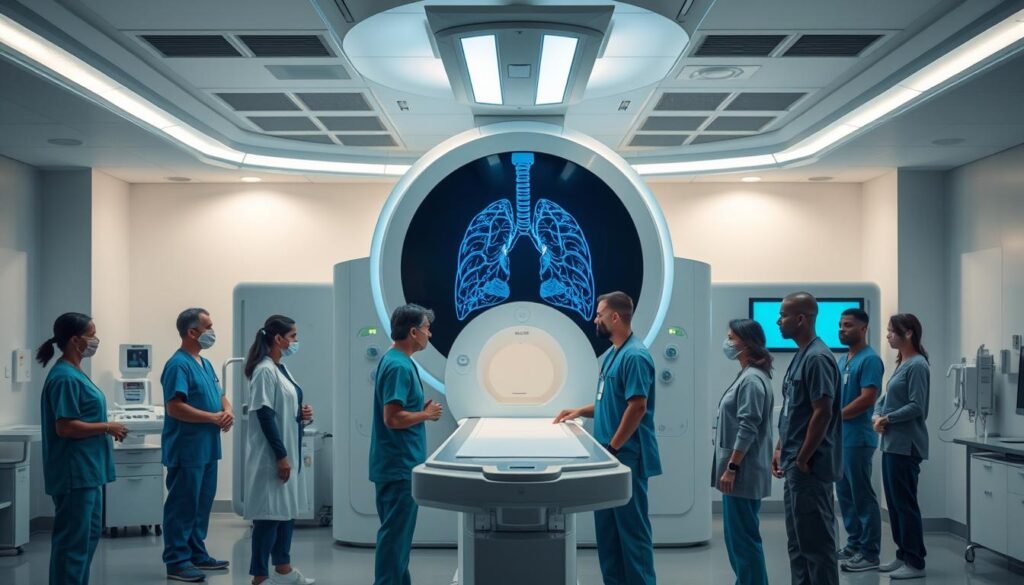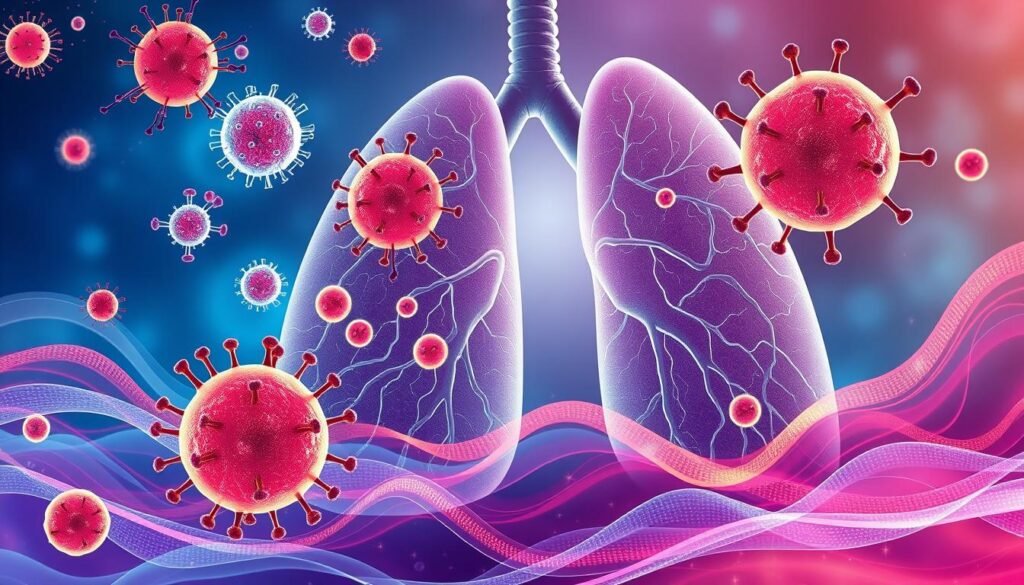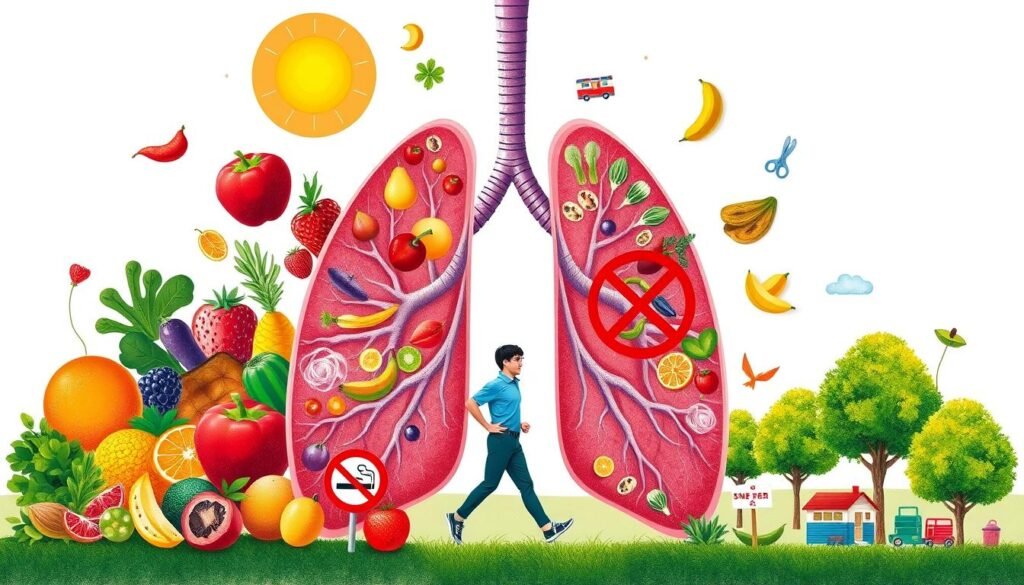Lung cancer is the top cause of cancer deaths among both men and women. It takes more lives than breast, prostate, and colon cancers combined. Knowing the signs and symptoms is key because finding it early can make treatment more effective.
It’s very important to act quickly if you think you might have lung cancer. Learning about early signs, risk factors, and how it’s diagnosed is crucial. This article will give you a step-by-step guide on what actions to take. This includes understanding symptoms, how to assess risks, the diagnosis process, and treatment options. You can find more details at Mayo Clinic.
Key Takeaways
- Early detection is critical for effective lung cancer treatment.
- Awareness of lung cancer symptoms can lead to timely medical evaluation.
- Discussing risk factors with a healthcare provider is essential.
- Diagnostic tests, such as imaging scans and biopsies, play a key role in confirming lung cancer.
- Understanding treatment options improves informed decision-making for patients.
Understanding Lung Cancer Symptoms
Knowing the signs of lung cancer is key for early detection and starting treatment. Many symptoms are not obvious and can be confused with minor illnesses. It’s important to spot these signs early to get the right help, which might lead to better outcomes.
Lung Cancer Early Warning Signs
Some common early symptoms are:
- Persistent cough that does not go away
- A change in how an existing cough feels
- Loss of weight without trying
- Pain in the chest
Noticing these symptoms early is crucial. If you see any of these signs, it’s smart to talk to a doctor. For deeper info, check out the American Cancer Society.
Common Symptoms to Watch For
As lung cancer gets worse, you might see:
- Feeling short of breath
- Spitting up blood while coughing
- Making wheezing sounds
- Getting infections in your lungs often
Being aware of these signs is vital for your lung’s health. Not paying attention to them can delay the treatment you need. Remember, lung cancer doesn’t always show signs at the start, which makes treating it harder as time goes on.
Assessing Lung Cancer Risk Factors
Identifying lung cancer risk factors is key in finding and stopping it early. Being aware of personal habits, places you’ve been, and family health can really affect your risk. Knowing these things helps you make smart choices for your health.
Personal Habits and Exposures
Smoking is the top risk factor for lung cancer. It’s linked to about 80% of lung cancer deaths in the U.S. Not just smokers, but even those around smoke, like secondhand smoke, are at risk too.
Things in your environment also play a big role in lung cancer risks. Radon gas is the second top cause among those who don’t smoke. People who work with asbestos are also at greater risk. Treatments like radiation for other cancers can increase your risk as well.
E-cigarettes are being looked into for their link to lung cancer. They’re still new, so more research is needed. The effect of smoking marijuana on lung cancer is still unclear too.
Family History and Genetics
Your genes matter a lot when it comes to lung cancer. If lung cancer runs in your family, or you’ve had it before, you should be extra careful. Regular health checks and screenings are important for those at higher risk. This helps in catching any problems early.
Research is finding out more about how allergies might affect cancer risks. Studies show a link between asthma and a higher chance of getting lung cancer. For more details, check out this link on allergies and lung cancer.
What to Do if You Suspect You Have Lung Cancer
Feeling worried about symptoms that might hint at lung cancer is natural. What should you do if you think you have lung cancer? The first thing to do is talk to a doctor. This chance to talk about what you’re feeling, your health history, and any risks is crucial.
Before your visit, make a list that includes:
- Symptoms like trouble breathing or coughing blood.
- Your and your family’s history with cancer.
- Medicines you’re taking and past treatments.
At your appointment, your doctor will check your vital signs and might run some basic tests. Based on what they find, they might suggest imaging tests. These tests help see if there’s anything unusual in your lungs. They might also send you to a specialist for more tests.
Acting fast is super important. Finding lung cancer early can make treatment more successful. Lung cancer is a top cause of cancer deaths worldwide. Knowing what steps to take if you’re worried about it is key.
Don’t be afraid to talk about your worries, ask questions, and get details on what comes next. Taking charge in this way can help you deal with a possible lung cancer diagnosis and figure out treatment options.
The Importance of Lung Cancer Screening
Lung cancer screening is key for finding cancer early when it’s easier to treat. The American Cancer Society urges high-risk people to get screened. This is crucial as lung cancer is the top cancer killer in the U.S. It’s vital to pick who should get screened carefully.
Who Should Get Screened?
If you’re between 50 to 80 years old and have smoked a lot, you should consider screening. This is especially true if you’ve smoked for 20 pack-years or quit in the past 15 years. Screenings have a major impact. They can significantly lower the death rate from lung cancer in these groups.
Available Screening Methods
The go-to method for lung cancer screening is the low-dose CT scan. It gives clear images with less radiation, spotting potentially cancerous spots in the lungs. It’s important that these scans are only done in well-equipped places by experts.

| Risk Factors | Screening Recommendations |
|---|---|
| Age 50-80 | Yearly LDCT scan for those meeting smoking criteria |
| 20 pack-year smoking history | Consider screening, especially for current or former smokers |
| Quit smoking within the last 15 years | Eligible for screening |
| History of lung cancer or lung diseases | Discuss screening options with a healthcare provider |
Screening for lung cancer can catch it early. This means better treatment options are available. It’s strongly suggested for those without symptoms. The goal is to fight lung cancer early on.
Lung Cancer Diagnosis: What to Expect
Getting diagnosed with lung cancer starts with detailed check-ups and looking into one’s medical past. Knowing the steps ahead can make patients feel ready and well-informed.
Health experts talk about symptoms and any risks in the initial meetings. It’s key for patients to tell all about their health history. This includes past illnesses and family health issues. Open talks help create a full health picture. This aids in figuring out if lung cancer might be a concern.
Initial Consultations and Medical History
At the start of diagnosing lung cancer, several factors are looked at:
- A full review of the patient’s health history
- Checking symptoms and current health problems
- Talking about family health history if it’s relevant
- Planning tests based on what’s found
It’s vital for patients to be proactive in these talks. Asking queries helps improve understanding. It gives clarity on possible worries about lung cancer.
Diagnostic Tests to Confirm Lung Cancer
After the early talks, doctors carry out tests. These tests confirm if it’s lung cancer. The tests include:
| Diagnostic Test | Purpose |
|---|---|
| X-rays | First step to spot any unusual signs in the lungs |
| CT Scans | They provide detailed images of the lungs. This helps see the structure and any odd lesions |
| PET Scans | These scans check how lung nodules behave. It helps tell apart harmless from harmful cells |
| Sputum Cytology | This test checks mucus for cancer cells in the breathing paths |
| Biopsies | Getting tissue samples to test in the lab. This confirms if it’s cancer |
Each test is crucial for confirming lung cancer. They find out the kind of lung cancer and its stage. This guides the choices for treatment.
Knowing about these tests allows patients to face their diagnosis boldly. It encourages them to take an active role in their health journey.
Understanding Imaging Tests and Biopsies
Imaging tests and biopsies are key in detecting lung cancer. These methods let doctors check for cancerous cells and plan the best treatment. Knowing about these tests can help patients take an active part in their care.
Common Imaging Tests for Lung Cancer
Doctors use several imaging tests to look for lung cancer. Each test gives valuable information on a tumor’s size and place:
- Chest X-rays: They are often the first step and can show lung changes.
- CT Scans: Provide detailed pictures, identifying smaller tumors.
- PET Scans: Useful for finding where cancer has spread by showing active areas.
- MRI: Recommended for seeing if cancer has reached the brain from the lungs.
- Ultrasound: Checks for fluid in the lungs.
Different Types of Biopsies
Biopsies are about taking tissue samples to verify cancer. The method depends on where the tumor is:
| Type of Biopsy | Description | Usage Context | Risks |
|---|---|---|---|
| Needle Biopsy | A thin needle extracts tissue from the lung. | Commonly used for accessible tumors. | Pneumothorax, bleeding, infection. |
| Transbronchial Biopsy | Uses a bronchoscope to reach the lungs. | Good for tumors in the center. | Small risk of bleeding, infection. |
| Thoracoscopic Biopsy | Done with video help to see the lung. | Best for big or complex tumors. | Risks with general anesthesia, infection. |
| Open Biopsy | Surgical removal of tissue. | For big growths or tough spots. | Bleeding, pain, complications after surgery. |
Understanding imaging tests and biopsies aids in lung cancer diagnosis. It leads to timely, effective treatment. Knowing each type’s risks helps patients discuss their care with doctors confidently.
Exploring Lung Cancer Treatment Options
Lung cancer treatments vary based on the disease type and stage. It’s important to know your options to make good choices. Surgery and therapies like radiation and chemotherapy are key. They help patients understand when surgery fits and the role of other treatments in care.
Surgery: When Is It Appropriate?
Surgery is key for early non-small cell lung cancer (NSCLC). It can remove localized tumors effectively. Sometimes, surgery is all you need, like in stage 0 NSCLC. Knowing when surgery is an option is crucial for those looking for a cure. Surgical options include:
- Lobectomy
- Segmental resection
- Pneumonectomy
For surgical treatment guidelines, check out lung cancer treatment resources.
Radiation and Chemotherapy Explained
Chemotherapy and radiation are vital for advanced non-small cell lung cancer. They can be used alone or with surgery. Stage IIIA NSCLC might need both, while stage IVB looks at targeted therapies from genetic tests.
Small cell lung cancer treatment usually includes both chemotherapy and radiation. It’s because this cancer type is very aggressive. The key treatments for lung cancer are:
| Treatment Type | Indication | Common Uses |
|---|---|---|
| Surgery | Early-stage NSCLC | Lobectomy, pneumonectomy |
| Chemotherapy | All stages, especially advanced | Combination with other therapies |
| Radiation Therapy | Stage III and IV | Palliative care, neoadjuvant therapy |
| Targeted Therapy | Advanced NSCLC | Based on genetic mutations |
Clinical trials are always finding new ways to treat lung cancer. Using these discoveries can make treatment plans better. It allows doctors and patients to work together on care.
Targeted Therapy and Immunotherapy
Cancer treatment has grown with targeted therapy and immunotherapy. They are key for lung cancer patients. These treatments work in different ways. They give hope and offer benefits based on the cancer’s unique traits.
What is Targeted Therapy?
Targeted therapy attacks specific genetic changes in cancer cells. For example, around 5% of people with non-small cell lung cancer (NSCLC) have changes in genes like ALK. Treatments like nintedanib focus on certain lung cancer types, such as adenocarcinoma.
Drugs also target mutations in EGFR and KRAS genes. They try to stop the cancer cells from growing and splitting. Biomarker tests are done to see which treatment will work best. This helps patients get the most effective therapy.
The Role of Immunotherapy in Treatment
Immunotherapy turns the immune system into a cancer-fighting tool. It uses drugs to help T-cells find and kill cancer cells. These drugs aim at PD-1 and PD-L1 proteins. Pembrolizumab and durvalumab are examples of these drugs. They are given to NSCLC patients at different stages.
Many patients have seen great results with immunotherapy. Take Donna’s story, for example. It helped keep her tumors stable for three years. This shows how powerful immunotherapy can be.
| Type of Therapy | Mechanism | Examples | Application |
|---|---|---|---|
| Targeted Therapy | Targets specific genetic mutations | Nintedanib, Sotorasib, Selpercatinib | Based on genetic profiling |
| Immunotherapy | Enhances the immune response | Pembrolizumab, Durvalumab | Used at various tumor stages |

Coping with Lung Cancer: Emotional and Physical Support
Dealing with lung cancer involves emotional and physical challenges. Patients find addressing their emotional health during treatment helpful. Strategies exist for managing feelings related to illness, and support groups are key for emotional support.
Managing Emotional Wellbeing
People react differently to lung cancer diagnoses. Some learn more about their condition, while others might withdraw or seek mental health advice. They commonly feel:
- Anxiety – Symptoms include a racing heartbeat and feelings of emptiness.
- Depression – Many face overwhelming sadness or guilt about their illness’s impact on loved ones.
- Loneliness – Emotional turmoil can cause this; support groups help decrease isolation.
Relaxation methods like belly breathing and muscle relaxation can help with anxiety. A healthy sleep routine and light exercise like yoga are also good for emotional health.
National and Local Support Groups
National and local support groups are crucial for those with lung cancer. LCRF.org and similar organizations offer peer networks, medical advice, and illness information. Patients can share experiences in these groups, feel less lonely, and connect with others facing similar challenges.
| Type of Support | Description |
|---|---|
| Local Support Groups | Provide community-based services, befriending opportunities, and practical assistance. |
| Online Support Communities | Facilitate connection through virtual meetings, helping bridge the gap between isolation and community. |
| Emotional Support Services | Offer counseling and emotional support through trained professionals, such as social workers and palliative care nurses. |
A lung cancer patient navigator can help individuals organize care. Finding effective support is key to improving emotional strength and life quality during treatment.
Lung Cancer Prevention Strategies
It’s vital to use smart strategies to prevent lung cancer. Making the right choices in life can really protect your lungs. Taking steps to stay healthy plays a big role in fighting this disease.
Healthy Lifestyle Changes
Avoiding tobacco is key for preventing lung cancer. Not smoking and staying away from secondhand smoke greatly reduce your risk. Eating lots of fruits and veggies can help too, but it’s not as effective as avoiding tobacco. Being active is also important for your lung health.
Avoiding Environmental Risks
It’s just as crucial to look out for environmental dangers. Checking your home for radon gas is an important step because radon is linked to lung cancer. Also, stay away from things at work like asbestos and heavy metals. These substances can increase lung cancer risk. Living in clean air matters too, as pollution can raise the chance of lung cancer. Protecting yourself from these risks is an important prevention step.

Conclusion
Lung cancer is a major issue in the U.S., being the third most common cancer. It’s also the top cause of cancer deaths. This underlines the urgent need for better awareness and knowledge. Everyone should watch for symptoms, consider their risk, and get regular checks. This is vital for those aged 50-80 who have smoked.
Getting screened often can find lung cancer early. This can cut death rates by as much as 20%. Finding cancer early greatly boosts survival chances. Also, knowing the treatment options, like surgery, chemo, or new methods like immunotherapy, helps patients choose the best path.
The battle against lung cancer isn’t just a personal one; it involves everyone. Community support, ongoing learning, and research progress are key. Sharing knowledge and creating a supportive space can help us all fight lung cancer more effectively. Together, we can work towards improved outcomes and a hopeful future in this fight.